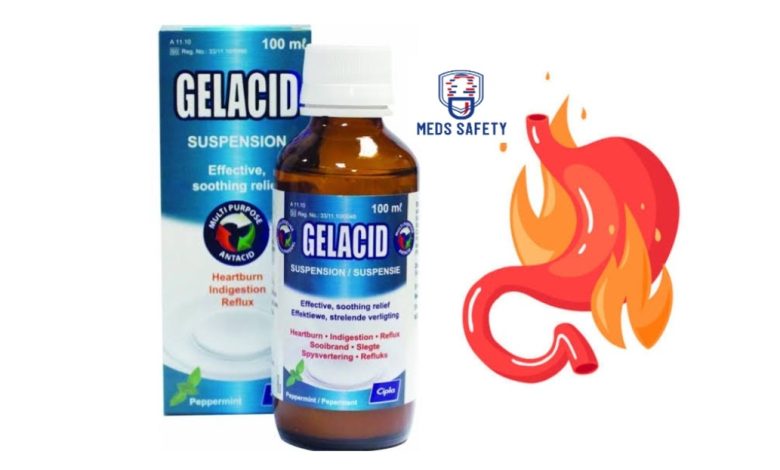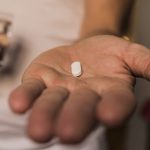Gelacid: Ingredients, Uses, Benefits, Dosage, Side Effects Interactions

What is Gelacid used for?
Gelacid Suspension is a that belongs to a class of drugs known as antacids. It is primarily used to treat symptoms of heartburn, indigestion, and gastric hyperacidity.
Gelacid Suspension works by neutralizing excess stomach acid and providing relief from symptoms such as a burning sensation in the chest or upper abdomen, acid reflux, and a sour taste in the mouth. It forms a protective coating on the lining of the stomach and esophagus, helping to reduce irritation and inflammation.
While Gelacid Suspension can provide short-term relief from symptoms, it is important to note that it does not treat the underlying cause of excessive stomach acid production. If you experience persistent or severe symptoms, it is recommended to consult a healthcare professional for a proper diagnosis and appropriate treatment plan.
What are the ingredients in Gelacid?
Gelacid Suspension contains the following active ingredients and preservatives per 10 ml:
• Sodium bicarbonate: 267 mg
• Sodium alginate: 500 mg
• Calcium carbonate: 160 mg
Additionally, Gelacid Suspension contains the preservative:
• Methyl hydroxybenzoate: 0.4% m/v
These ingredients work together to provide relief from symptoms of heartburn, indigestion, and gastric hyperacidity. Sodium bicarbonate helps to neutralize stomach acid, while sodium alginate forms a protective layer on the stomach lining to prevent acid reflux. Calcium carbonate is an antacid that can also neutralize excess stomach acid.
Gelacid Dosage
The dosage of Gelacid Suspension can vary depending on the individual’s age, the severity of symptoms, and the guidance of a healthcare professional. It is important to follow the recommended dosage instructions provided by your doctor or the instructions mentioned on the product label.
As Gelacid Suspension contains multiple active ingredients, the dosage may be specified for each ingredient separately or as a combined dosage. It is crucial to carefully read the instructions and clarify any doubts with your healthcare professional or pharmacist.
Generally, Gelacid Suspension is taken orally. Shake the bottle well before use to ensure proper mixing of the suspension. Use a measuring device provided with the medication to ensure accurate dosing. Do not use household spoons as they may not provide accurate measurements.
It’s important to note that dosages can vary for different age groups. The following dosage information is for general reference purposes only, and you should always consult your healthcare professional for personalized dosage recommendations:
• Adults and adolescents: The typical recommended dosage for adults and adolescents is 10 to 20 ml (1 to 2 measuring spoons) of Gelacid Suspension after meals and at bedtime, or as directed by a healthcare professional.
• Children: The dosage for children may vary based on their age and weight. It is crucial to consult with a pediatrician or healthcare professional to determine the appropriate dosage for children.
Remember to adhere to the prescribed dosage and duration of treatment. If you have any concerns or questions about the dosage of Gelacid Suspension, it is best to consult with your healthcare professional or pharmacist for personalized advice.
Is Gelacid safe during pregnancy and breastfeeding?
Gelacid Suspension is generally considered safe during pregnancy and breastfeeding. However, it is always recommended to consult with a healthcare professional before using any medication during these periods. They can provide personalized advice based on your specific situation and consider any potential risks and benefits.
Regarding Gelacid Suspension, the active ingredients are sodium bicarbonate, sodium alginate, and calcium carbonate. Here is some general information regarding the safety of these ingredients during pregnancy and breastfeeding:
1. Sodium Bicarbonate: Sodium bicarbonate is generally considered safe for short-term use during pregnancy and breastfeeding when used as directed. However, prolonged or excessive use should be avoided as it may lead to an imbalance in electrolytes. It is always best to consult with a healthcare professional before using sodium bicarbonate or any other medications during pregnancy or breastfeeding.
2. Sodium Alginate: There is limited information available on the safety of sodium alginate specifically during pregnancy and breastfeeding. While it is commonly used in antacid medications, it is advisable to consult with a healthcare professional for personalized advice and to weigh the potential risks and benefits.
3. Calcium Carbonate: Calcium carbonate is often used as an antacid during pregnancy and breastfeeding. It is generally considered safe when used as directed. Calcium is an essential mineral for both the mother and the developing baby. However, it is still recommended to consult with a healthcare professional before using calcium carbonate or any other medications.
During pregnancy and breastfeeding, it is important to consider the potential risks and benefits of any medication. The healthcare professional will evaluate your specific situation, taking into account factors such as the stage of pregnancy, the dosage, the duration of use, and your overall health.
It is also worth noting that there may be alternative treatment options or lifestyle modifications that can help manage symptoms of heartburn or indigestion during pregnancy and breastfeeding. Your healthcare professional can provide guidance on these as well.
Ultimately, it is important to have a discussion with a healthcare professional to make an informed decision regarding the use of Gelacid Suspension or any other medications during pregnancy and breastfeeding.
Gelacid Suspension side effects
Gelacid Suspension can cause some side effects. While not everyone experiences these side effects, it is essential to be aware of potential adverse reactions. Common side effects associated with Gelacid Suspension may include:
1. Gastrointestinal Disturbances: These can include constipation, diarrhea, stomach discomfort, bloating, or flatulence.
2. Altered Bowel Movements: Gelacid Suspension may cause changes in bowel movements, such as an increased frequency of bowel movements or changes in stool consistency.
3. Allergic Reactions: In rare cases, allergic reactions may occur, which can include symptoms like rash, itching, swelling, dizziness, or difficulty breathing. If you experience any signs of an allergic reaction, seek immediate medical attention.
4. Electrolyte Imbalance: Excessive or prolonged use of Gelacid Suspension, particularly containing sodium bicarbonate, may disrupt the balance of electrolytes in the body, such as sodium and potassium. This is more likely to occur with high doses or long-term use.
5. Kidney Problems: Although rare, long-term use of certain antacids containing aluminum (not specifically Gelacid Suspension) may contribute to the development of kidney stones or other kidney problems.
It is important to promptly report any unexpected or severe side effects to your healthcare professional. They can provide guidance on managing these side effects or recommend alternative treatments if necessary.
Please note that the above list is not exhaustive, and other side effects may occur. Additionally, individual responses to medications can vary, so it is important to consult with a healthcare professional or pharmacist for personalized advice and information regarding Gelacid Suspension’s side effects.
Interactions
Gelacid Suspension may interact with other medications or substances. It’s important to inform your healthcare professional about all the medications, supplements, and herbal products you are taking to minimize the risk of potential interactions. Here are some known interactions associated with Gelacid Suspension:
1. Drug Interactions:
• Tetracycline antibiotics: Gelacid Suspension may interfere with the absorption of tetracycline antibiotics, so it is generally recommended to take these medications at least 2 hours apart.
• Iron supplements: Gelacid Suspension may decrease the absorption of iron supplements. To ensure adequate iron absorption, it is generally advised to take iron supplements at least 2 hours before or after Gelacid Suspension.
• Quinolone antibiotics: Gelacid Suspension may reduce the absorption of quinolone antibiotics. It is generally recommended to separate the administration of Gelacid Suspension and quinolone antibiotics by at least 2 hours.
• Ketoconazole: Gelacid Suspension may reduce the absorption of ketoconazole, an antifungal medication. It is generally recommended to separate the administration of Gelacid Suspension and ketoconazole by at least 2 hours.
2. Medical Conditions:
• Kidney disease: Gelacid Suspension contains aluminum, which can accumulate in the body and may cause toxicity in individuals with impaired kidney function. It is generally advisable to use caution and consult a healthcare professional before using Gelacid Suspension if you have kidney disease or impaired renal function.
It’s important to note that this is not an exhaustive list of interactions, and other medications or substances may interact with Gelacid Suspension. Always consult your healthcare professional or pharmacist for personalized advice based on your specific medical history and current medications.
Remember to follow the recommended dosage and administration instructions for Gelacid Suspension and inform your healthcare professional about any changes in your medication regimen to ensure safe and effective use.





